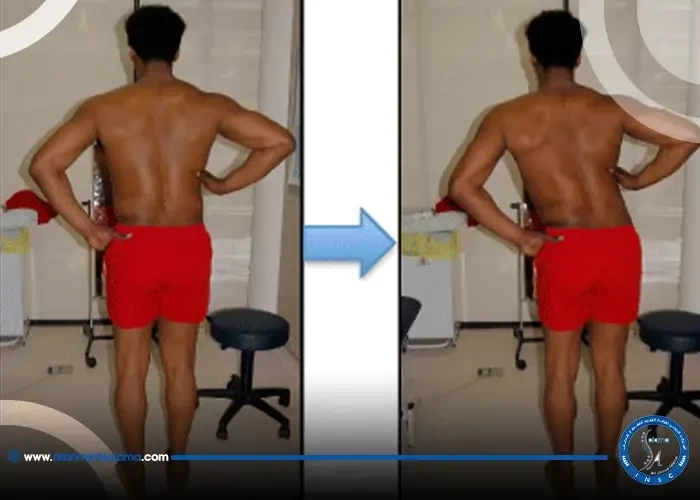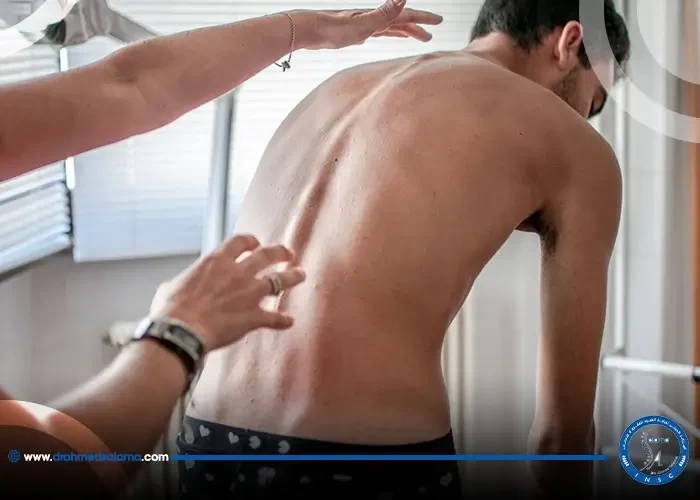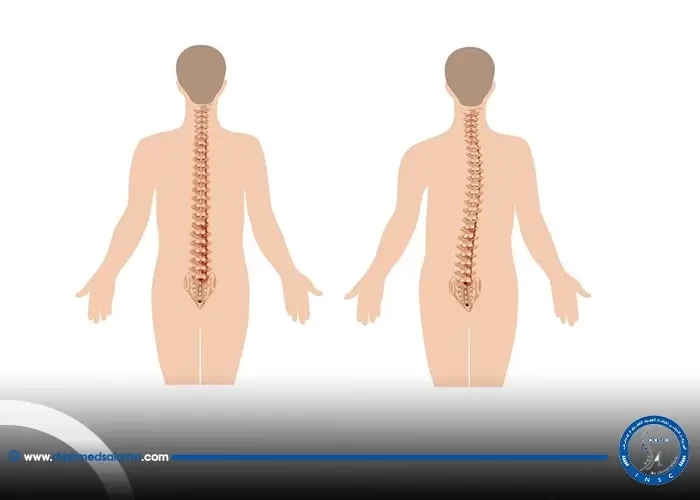Nasr City, 52 El Tayaran Street, in front of the Health Insurance Hospital

Treatment of spinal curvature

It's normal for the spine to appear straight when viewed from the back. When viewed from the side, a slight curvature is seen. However, a severe curvature of the spine is a medical condition that requires treatment for scoliosis.
In this article, we will learn about the causes of scoliosis, its symptoms,
treatment methods for scoliosis, and other important information about scoliosis, with Dr. Ahmed Salama, a consultant neurosurgeon and endoscopic spine surgeon.
Causes of Scoliosis
Before discussing treatment for scoliosis, let's first understand its causes. There are many causes that can lead to scoliosis, the most common of which are:
Congenital and genetic defects. Some children may be born with scoliosis.
Spondylolisthesis can lead to scoliosis.
Irregular bone growth, which often accompanies dwarfism and short stature.
Obesity, as excess weight puts pressure on the vertebrae of the spine, which can lead to curvature.
Osteoporosis, as fragility of the vertebrae can lead to curvature.
Diseases affecting the spine can lead to curvature, including a herniated disc, disc inflammation in the back, a tumor in the spine, and other conditions.
Treatment of scoliosis with a belt
Symptoms of scoliosis
One of the most common symptoms of scoliosis is a visible curve in the back. Other symptoms include:
Uneven shoulders, where one shoulder may appear higher than the other.
Prominent ribs on one side of the body.
One hip may be higher than the other.
If the spine is curved inward, the buttocks may protrude.
Spine stiffness, which is evident when the patient is unable to perform certain positions while sitting or standing.
Lower back pain, sometimes extending to the legs and feet.
General weakness resulting from muscle strain.
Your first visit to Dr. Ahmed Salama, a consultant neurosurgeon and endoscopic spine surgeon, is the right start to determine the appropriate treatment for your scoliosis and alleviate these annoying symptoms.
Spinal Curvature Treatment
Treatment for scoliosis depends on the degree and severity of the curvature, mild spinal deviation, and the patient's general condition. In mild and moderate cases, exercises to strengthen the muscles surrounding the spine and the use of special support belts can help reduce the progression of the curvature. Non-surgical endoscopic scoliosis correction has become a modern technique that offers an effective, non-surgical solution for correcting spinal curvature. This method allows for reduced pain and faster recovery compared to traditional surgeries. In more severe cases, the patient may require surgical intervention, but with recent developments, it has become possible to resort to less invasive techniques that provide good results with reduced risks. In addition, physical therapy plays an important role in improving posture and relieving pain, helping patients regain a better quality of life.
Lumbar Spinal Canal Dilation
Complications of Scoliosis
Many people with this condition may not experience symptoms of scoliosis, or these symptoms may be mild. However, neglecting to treat scoliosis may expose some patients to several serious complications, including:
In severe cases of scoliosis, the patient may experience significant difficulty breathing, as the rib cage exerts excessive pressure on the lungs.
Severe spinal curvature may lead to chronic back pain.
The patient's overall appearance may change, especially as scoliosis symptoms worsen. Prominent ribs may appear, along with uneven hips and shoulders. We may also notice a shift in the waist and torso to one side. This can cause psychological problems for some patients.
Non-Surgical Spinal Stabilization
Diagnosing Scoliosis
Diagnosing scoliosis involves several stages to determine the appropriate treatment for each case. These stages include:
Physical Examination: The first stage of diagnosing scoliosis is a clinical examination, during which the doctor asks the patient to perform certain movements to determine the curvature of the spine.
If the doctor suspects the patient may have scoliosis, he may order an X-ray to determine the extent and severity of the injury and to determine the appropriate treatment for scoliosis.
The doctor may also order an MRI to rule out tumors that may have caused the scoliosis.
Best Doctor for Brain Tumor Treatment
Scoliosis and Its Impact on Marriage
Scoliosis, whether in the form of scoliosis or any other condition, can affect an individual's life in many ways, including marital life. Physically, the affected person may experience back pain or difficulty moving, which can affect their ability to perform some daily and intimate activities. This persistent pain can lead to tension in a marital relationship, as the affected person may feel like a burden to their partner.
Psychologically, individuals with scoliosis may experience a lack of self-confidence due to the condition's impact on their physical appearance, which can lead to feelings of isolation or anxiety about how others perceive them. This can indirectly impact emotional and intimate interactions within a marital relationship.
Fortunately, there are several treatment options that can help mitigate the impact of scoliosis on marital life. For example, a medical back belt can be used to treat back and spine curvature, providing support to the spine and reducing pain. Physical therapy can also be effective in strengthening the muscles surrounding the spine, which contributes to improved mobility and reduced pain. In some cases, some may wonder whether a back brace can treat back curvature. The answer is yes, it helps correct the spine's posture and helps reduce symptoms.
In addition, a back brace may be worn for a certain period after consulting a doctor to help improve the spine's posture. Non-surgical treatment of scoliosis can be achieved through physical therapy techniques, which aim to strengthen muscles and improve flexibility. Treating scoliosis and physical therapy can be part of a long-term solution to reduce symptoms and improve quality of life.
Ultimately, both partners should realize that physical challenges should not hinder the building of a strong and sustainable relationship; rather, they can become an opportunity for closeness and mutual support. Devices such as a scoliosis belt can provide the necessary support, contributing to improved health and marital life.
Endoscopic Lumbar Vertebroplasty
Steps for Treating Scoliosis in Adults
The treatment plan doesn't differ significantly for both children and adults. The treatment stages for scoliosis can be divided into three levels, as follows:
Exercise Treatment for Scoliosis
Mild cases of scoliosis often don't require any treatment. However, ongoing follow-up with a specialist physician is necessary, who will monitor the patient's condition through occasional x-rays to ensure the condition is stable.
Regarding exercise, there is currently no scientific evidence confirming the role of exercise in treating scoliosis. However, exercise may help treat muscle weakness and imbalance. However, it should be done under the supervision of a physical therapist, as certain exercises can place significant pressure on the spine and exacerbate symptoms.
Curvature of the spine with a belt
Curvature of the spine with a belt is one of the methods for treating moderate cases of scoliosis. Doctors may prescribe a back brace—especially for children who are still growing—which can prevent the condition from worsening.
Surgical treatment of scoliosis
For severe cases of scoliosis, the appropriate treatment is spinal fusion surgery, whether performed through traditional surgery or endoscopic spinal fusion surgery (minimally invasive surgery).
If you would like more information about scoliosis treatment methods, you can contact us via WhatsApp or the text message service located on the homepage of Dr. Ahmed Salama's website. A medical team is available to answer all your inquiries.
Best Painkillers for Scoliosis
Pain-relieving medications may help relieve pain associated with scoliosis. Nonsteroidal anti-inflammatory drugs (NSAIDs), such as ibuprofen, are usually the recommended treatment. However, we emphasize that NSAIDs are not suitable for all patients; therefore, consult your doctor before taking any medication.
Herniated Disc of the Fifth and Sacral Vertebrae
Endoscopic Scoliosis Correction
Endoscopic scoliosis correction is an advanced surgical procedure used to treat spinal curvature problems such as scoliosis or scoliosis. This type of surgery is less invasive than traditional surgery, as it uses an endoscope to make small incisions in the skin, reducing pain and post-operative recovery time. During the procedure, the surgeon corrects the curvature using precise instruments and small cylinders, while minimizing potential damage to surrounding tissue. This method is ideal for patients with mild to moderate scoliosis, and it also speeds up recovery and reduces hospital stays.
Non-Surgical Brain Tumor Treatment
Preventing Scoliosis
We can avoid seeking treatment for scoliosis by following tips that reduce the risk of developing this condition. Dr. Ahmed Salama offers a set of tips for preventing scoliosis, the most important of which are the following:
We must educate our children from an early age on proper nutrition and regular exercise, and continue doing so throughout their lives.
Conduct regular checkups for early detection of scoliosis and osteoporosis.
Maintaining a healthy weight and losing excess weight is essential through follow-up with a specialist.
Avoid sitting or standing for long periods of time, and constantly change your body position.
Wear comfortable shoes while moving around, and avoid high-heeled shoes, as they can damage the spine.
Avoid sleeping on high pillows. Also, choose a mattress that is comfortable for your back. It is also preferable to avoid sleeping on your stomach, as it causes severe pressure on the spine.
Is it possible to permanently recover from a herniated disc?
The Best Doctor for Scoliosis Treatment
Dr. Ahmed Salama, a consultant neurosurgeon and endoscopic spine surgeon, is one of the best doctors for treating scoliosis. This is due to his many advantages, including:
Dr. Ahmed Salama is a consultant neurosurgeon and spine surgeon.
Dr. Ahmed Salama holds a PhD in neurosurgery and spine surgery. His doctoral dissertation discussed methods for correcting spinal deformities.
Fellow of the American Society for Spinal Deformities.
Member of the Egyptian and European Society of Neurosurgeons.
Member of the Swiss and American Society of Spine Surgeons.
He relies on modern techniques in treating scoliosis.
In conclusion, we have covered the various methods used to treat scoliosis, and explained its causes and symptoms. For more information or to book an appointment with a doctor, you can contact us via the numbers listed on the home page of our website. Our specialized team will answer all your inquiries.
What are the benefits of treating scoliosis with a belt?
The benefits of treating scoliosis with a belt include limiting vertebral movement and immobilizing the entire trunk, which helps treat deformities without resorting to surgery.





